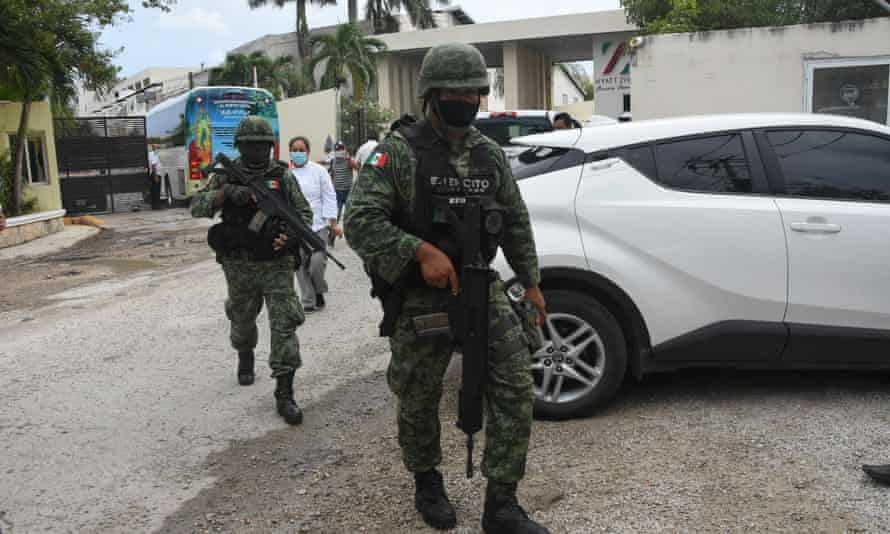[ad_1]
Fifty years ago, Cancún was little more than a hurricane-battered fishing outpost, but it mushroomed into a tourist mecca thanks to massive government investment – and by the 1980s it was firmly established as the crown jewel of Mexico’s tourist industry.
Millions of tourists from around the world descend annually on the destination and the Riviera Maya, which unfolds to the south.
But success has brought other, less welcome visitors, too. Criminal groups run extortion rackets and peddle drugs. And its location on the eastern side of the Yucatán peninsula makes an ideal way station for drug runners moving cocaine out of Central and South America.
This week, the two Cancúns collided in spectacular fashion when a dispute between drug dealers led to gunfire and murder on the beach outside a luxury hotel packed with foreign visitors.
Officials say 10 or 11 masked men stormed the beach outside the Hyatt Ziva hotel south of Cancún, shooting dead one member of a rival faction. A second man attempted to hide in a hotel room but was dragged away with the assailants as they fled in a stolen boat.
All the while, guests hid in their rooms and sent out SOS messages and pleas for intervention over social media. Four American citizens were injured in the assault, a US official told ABC news.
Local officials described the violence as a fight over the local drug market.
According Vicente Carrera, publisher of the news site Noticaribe in Quintana Roo, at least seven rival cartels are present in the region, where they control drug dealing and extortion rackets.
“I’m certain all the narco groups in the country have a presence here due to the importance of the Quintana Roo drug sales territory and the value of tourism,” he said.
“It’s the mutation of Mexican organised crime over the past 15 to 20 years,” Falko Ernst, senior Mexico analyst for the International Crisis Group. “We see groups increasingly drifting toward or complementing or substituting drugs trafficking for extortion markets … They don’t produce, ship or export anything any more.”

Cancún’s economy crashed when the coronavirus pandemic arrived. It marked its 50th anniversary without celebration in 2020. But the destination has bounced back – partly because Mexico has not required Covid tests for entering the country or banned travellers from pandemic hotspots.
Violence continues plaguing the region, however. Last month, a California travel blogger and a German tourist were killed at a restaurant in Tulum, 200km south of Cancún, during a shootout between suspected gang members.
Carrera said there had been plenty of killings on the same tourist strip in Tulum, “but no tourists were caught up in them, so it seems like it was no big deal”.
But violence involving foreign visitors threatens a major local industry: tourism represents 8% of Mexico’s GDP. Quintana Roo’s governor, Carlos Joaquín, told Mexican media the beach assault “put the image of the state at grave risk”.
Local officials have long insisted that Cancún is safe for tourists – and have invested heavily in areas visited by foreigners – in stark contrast to the neglect shown the neighbourhoods housing the armies of poorly paid hospitality workers.
“There is a sincere concern on the part of the government to protect more tourist areas than popular areas,” Carrera said. “But this strategy is no longer working: they can no longer guarantee the safety of tourists.”
[ad_2]
Source link












